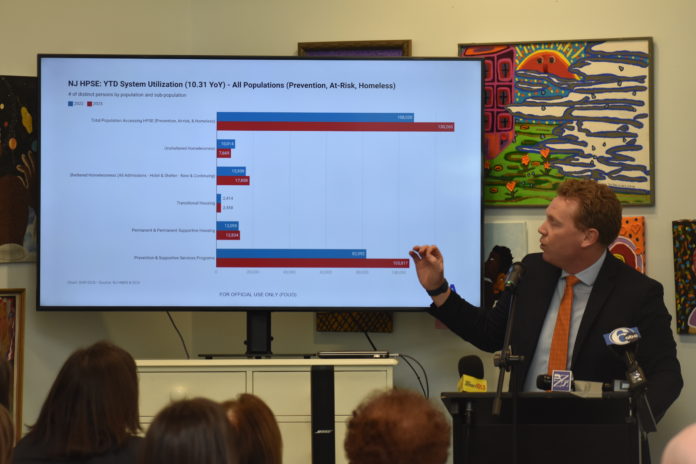
New Jersey is experiencing a 23.4% decline in unsheltered homelessness, according to the state’s Department of Community Affairs (DCA).
The DCA also announced that there was an increase in access to prevention programs, which aid to keep people from becoming homeless, at a press conference inside Homefront in Lawrenceville on Nov. 13.
“The latest data shows that unsheltered homelessness is down 23.4% for the end of October from where it was this time last year and also shows there was a 28.9% increase in households accessing prevention programs,” said Jacquelyn Suárez, acting commissioner for DCA.
“We have hope for the future, we do. We are optimistic about reaching the federal target of 25% reduction in unsheltered homelessness by 2025. We are close.”

The state has released the DCA’s 2023 Statewide Office of Homelessness Prevention (OHP) update brief and 2022 Office of Homelessness Prevention Annual Report.
“All of us collaboratively have walked through – what is honestly in my view – one of the greatest human services’ crises of a generation,” said Michael Callahan, director of OHP, who spoke of the COVID-19 pandemic.
“There were 11,265 people that experienced unsheltered homelessness in 2022,” Callahan said calling the numbers “brutal.”
The year-to-year for unsheltered homelessness was a 20% increase from 2021.
In 2022, 16,566 people experienced sheltered homelessness, which was a 17% increase from 2021, according to the OHP 2022 annual report.

“There is often one fact that gets rolled over and that is the 27% increase in the number of people accessing prevention programs,” Callahan said. “We have never seen more people throughout the state need access to preventative mechanisms and their conventions, but also to give information just in case.”
He explained that at this point last year there were 10,014 people experiencing unsheltered homelessness. At this time in 2023, 7,669 people experiencing unsheltered homelessness, close to 2,500 people less.
“Importantly there are 17,858 people that have experienced sheltered homelessness and access to their shelters. But often times when we see both those numbers together, we think oh that’s a bad thing, but no it’s not,” Callahan explained.
He noted that one of the numbers that OHP is “proud” of is 105,817 people have accessed prevention services in 2023. The number of people increased from the 82,092 people who accessed preventions services in the previous year.
“We love our diversion program. Why do we love our diversion program, because for less than $670 on average it costs per household, 97% of families in this program never enter shelters,” Callahan explained.
The homelessness diversion programs aim to help people facing housing crises by identifying alternative housing arrangements, providing no or low-barrier financial assistance, offering mediation and problem-solving support and prevent people from entering the homelessness services system, according to OHP.
“We broke the wave,” Callahan said of the 1.3% reduction in the year-over-year homelessness total.
If the five-year projection for homelessness in the state continued unabated there would have been over 35,000 people experiencing homelessness so far this year.
“There have been 27,985 people experiencing homelessness,” Callahan said, adding “that might sound a little morose to talk about that as a win but guess what it is.”
There have been 27,985 people experiencing homelessness, he added. Callahan said, “that might sound a little morose to talk about that as a win but guess what it is.”
In the 2023 OHP’s update brief, the leading cause of homelessness was being asked to leave a shared residence, followed by eviction, other causes, job income loss and reduction, relocation and release from prison and jail.
“Eviction is the second leading precipitating cause of homelessness throughout the state. Importantly it is not just that the leading precipitating cause is being asked to be to leave a shared residence,” Callahan noted.
“It is not being diagnosed with a mental illness, it is not because you are struggling with addiction, it is because you are a normal person struggling with the realities of our economy.”
When broken out by families – 65.2% of all single parent families with a male head that are experiencing homelessness in the state of New Jersey in 2023 were Black or African American and 61.78% of all single parent families with a female head that experienced homelessness whether sheltered or unsheltered were Black or African America.
“So, as we move towards developing key performance indicators and draw different outcomes, we need to put equity at the forefront,” Callahan said, adding with a two-party verification for shelter and unsheltered homeless numbers, they are confidents in the numbers that have been reported.
“… If someone interfaced with a street outreach worker that is a two-party verification of the homeless, cause it’s with the person reporting that, then there is a street outreach worker validating that,” he said.
“On the flipside, someone might call right and say I’m experiencing unsheltered homelessness if there is not a validation of that, that person calls NJ 211 (arranges emergency placement) and was able to get them a ride to an emergency shelter then at that intake we are able to validate them.”
Homefront, which helps the homeless and working poor, was chosen as the venue for the press conference as way to see how operations are at the organization and the need.
“But I bet many of you have not been here and we chose here intentionally today because this is where we do the bulk of our work to prevent homelessness,” Homefront CEO Sarah Steward said.
“We are proud of our work sheltering families and serving families that are experiencing homelessness, but we are also really proud of our work to do that prevention, so we don’t see more families that have to visit our family campus.”
She noted that Homefront intentionally did not take anything offline for the press conference.
“Because it is important to the family’s we serve,” Steward added. “Partnerships are really critical to the work that we do together and the progress we are going to make together.”

